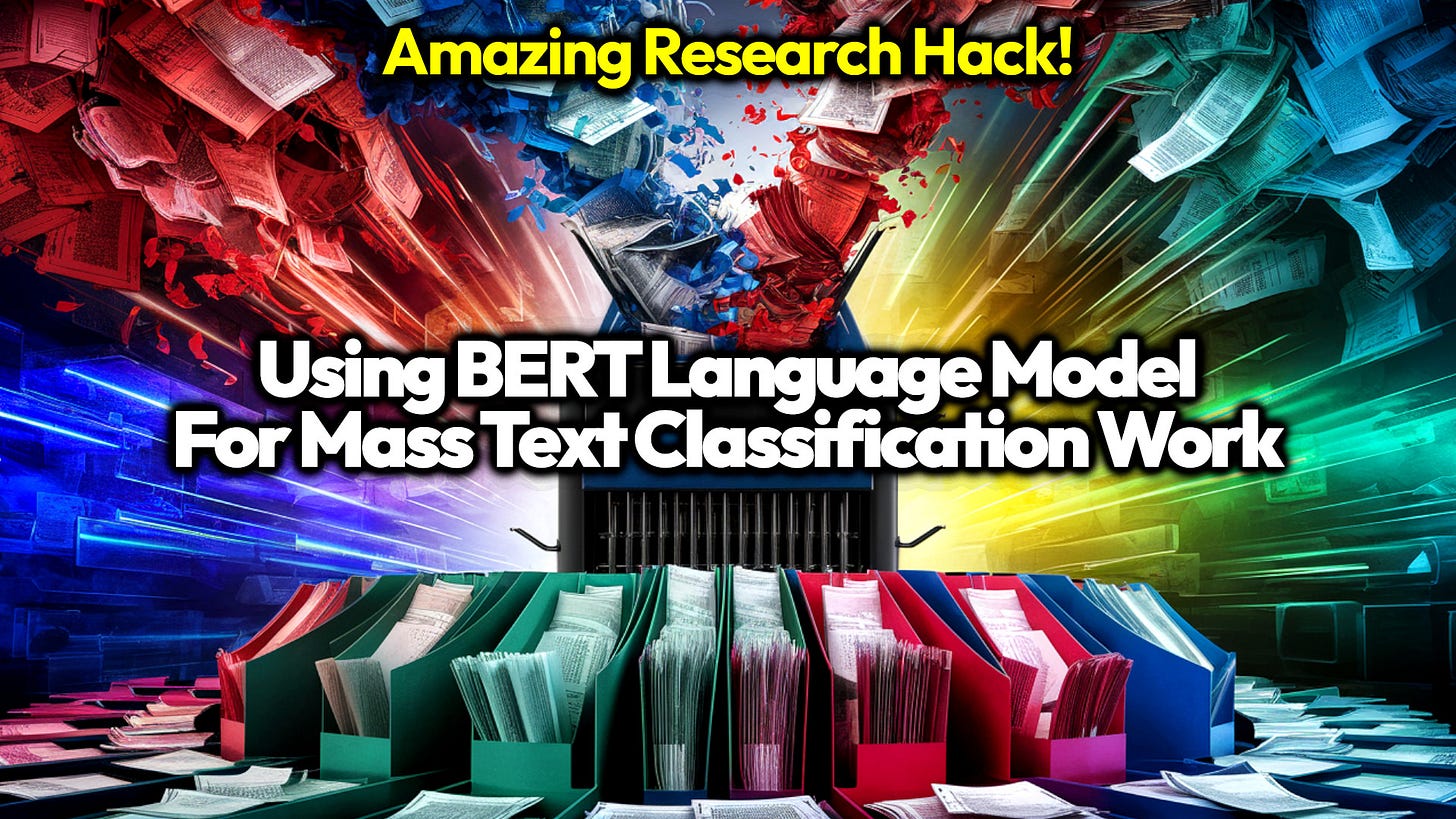Research Productivity Hack: Using BERT Language Model For Text Classification Grunt Work
Unlock the Power of BERT: Transforming Text Data into Knowledge
Introduction
Imagine a tool that can sift through billions of text records, intelligently categorizing them according to your specific preferences. What if you could train this tool to help you find the information that matters most to you? Welcome to the world of BERT (Bidirectional Encoder Representations from Transformers), a breakthrough in machine learning that offers you the power to customize, enhance, and optimize your text classification processes.
What is BERT?
BERT is a free language model developed by researchers at Google. It stands out because of its ability to understand the context of a word in a sentence from both directions (left and right of the word), unlike traditional models which read text linearly (left to right or right to left). This enhanced understanding enables BERT to grasp the full essence of English language, making it incredibly effective for tasks involving the comprehension of complex text.
Why Choose BERT?
Personalized Data Handling: Train BERT with examples from your datasets to recognize patterns to skillfully categorize text to your liking. Whether sorting emails, categorizing research papers or books, BERT is a high performance tool that can not just save you a massive amount of time but can facilitate tasks previously impossible.
Efficiency and Accuracy: Reduce the time spent on manual data sorting. BERT's ability to understand nuances in text ensures high precision in categorization, making your data more actionable and accessible.
Scalable Solutions: From independent researchers to large enterprises, BERT's capabilities scale to handle datasets of any size, ensuring consistent performance regardless of the volume of data.
Video Walkthrough
Watch link: https://odysee.com/Bert-text-classification:b64f366faf78b064975916a2586168e98335c7d4
Getting Started with BERT
Prepare Your Data: Start with a labeled CSV spreadsheet that represents your typical data and desired categories.
Train Your Model: Use the spreadsheet to train BERT on recognizing and categorizing your specific types of data.
Deploy and Predict: Once satisfied, deploy BERT to categorize new data and make predictions that help drive your decisions.
Example
The example we’ll look at today is how can we find books of interest in a long list of books in a csv file that looks like this:
title, subjects, interest
"Deep Learning","AI, Machine Learning","No"
"History of Europe","History, Geography","Yes"
"English Etymological Dictionary","Etymology, English","Yes"
"Machine Vision","Computer Science, AI","No"
"Fundamentals of Quantum Mechanics","Physics, Quantum Theory","No"
"Introduction to Abstract Art","Art, Modern Art","No"
With BERT we can train it on our preferences on just 100-200 records and then have it find all the books that we are interested in from a huge list of millions or even billions of book titles.
Conclusion
BERT is your partner in your quest to master the categorization and classification the overwhelming world of data. With BERT you are deploying an intelligent system tailored to understand and categorize your data with unprecedented accuracy. Unlock the full potential of your text records and transform them into valuable insights that can propel your research or professional work forward.
Download my code library & documentation here & hit the ground running!
Are you ready to harness the power of BERT for text classification to increase your productivity in text sorting tasks many-fold? Imagine having a tool that can sift through a list of books and mark each as "interesting" or "not interesting" based on your unique tastes. Our comprehensive code library with usage examples and detailed documentation provide everything you need to implement this functionality swiftly.
My supporters get a zip archive with great reusable python code and usage scripts that can easily be tailored for your other text classification problems. Included are custom classes such as ClassifierDataStreamer for efficient data handling and TextClassifierModelTrainer for robust model training. Additionally, our ready-to-use scripts, TextClassifierTrainModel.py and TextClassifierRunFromSavedModel.py, streamline the entire process from training to prediction.
ClassifierDataStreamer:
Handles loading and preprocessing of CSV data.
Tokenizes texts and prepares batches for training/validation.
TextClassifierModelTrainer:
Manages the training process using the provided data and model configuration.
Supports saving and loading of the model.
TextClassifierTrainModel.py:
Purpose: This script is designed to train a text classification model using specified training data.
Key Features:
Initializes the tokenizer, data streamer, and model trainer.
Sets up the training configuration
Performs the training process and saves the trained model.
Customization: Users can modify the script to change the dataset path, model configuration, and training parameters based on their specific needs.
TextClassifierRunFromSavedModel.py:
Purpose: Used to load a previously trained model and make predictions on new text data.
Key Features:
Loads the model from a saved file and initializes the tokenizer.
Customization: Adjust the script to point to the correct model file and modify the input data format according to your requirements.
Download now and transform your textual data into actionable insights with just a few clicks!
Click this link to download a self-contained zip archive that contains the python classes and script examples so you can get started right away.


